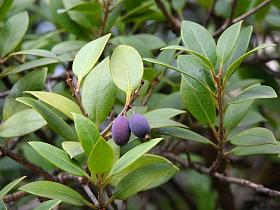False Holly, Holly Osmanthus
or Osmanthus aquifolium, Osmanthus heterophyllus 
 Etymology: False-Holly because of its tough leaves resembling those of the holly (but they have smooth margin). Its Latin-Greek name, Osmanthus aquifolium, means "plant with fragrance with leaves provided with sharp teeth" (as the Holly, Ilex aquifolium). Osmanthus heterophyllus specifies "with variable leaves". Etymology: False-Holly because of its tough leaves resembling those of the holly (but they have smooth margin). Its Latin-Greek name, Osmanthus aquifolium, means "plant with fragrance with leaves provided with sharp teeth" (as the Holly, Ilex aquifolium). Osmanthus heterophyllus specifies "with variable leaves".
Origin: China, Japan, Taiwan, discovered at the end of the XIXth century.
Hardiness: zone 7 (it supports cold until -17 °C or 1 °F). In cold region, it is recommended to protect roots with a Mulching in winter, the first years according to the planting.
Height: 3-4 m tall.
Rate of Growth: slow.
Shape: in dome.
Persistent foliage. Dark green, bright leaves, prickly teeth resembling those of the holly when they are young.
Flowers: tubulars white, very sweet-scented (scent reminiscent of jasmine), appearing from middle to end of the spring; grouped in compact clusters.
Fruits blue-black, of the size of a small olive, present on the False Holly until next spring (photo above taken in May).
Use: the osmanthus is planted insulated or in hedge, for its persistent foliage resembling that of the holly and its very sweet-scented late blossoming.
Pruning (maintenance): in middle-summer to keep a very compact form, but it is not necessary.
Cultivars:
' Aureomarginatus ' with leaves margins in yellow.
' Myrtifolius ' with slim myrtle leaves.
' Purpureus ' with young shoots dark purple becoming dark green shade of purple.
' Rotondifolius ' with small rounded leaves and without thorns.
' Variegatus ' with variegated leaves.
|